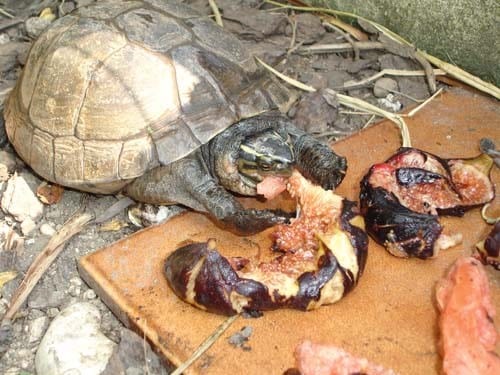Scientific Facts
| Common Name: | Asian Box Turtle |
| Scientific Name: | Cuora Amboinensis |
| Life Span: | Up to 100 years or more |
| Length: | Up to 12 inches |
| Clutch Size: | 1 to 5 eggs |
| Habitat: | ponds, streams or shallow swamps |
Physical Description

There are four subspecies of Asian box turtles. They generally range in size, depending on their geographical location. The smaller ones measure 5 to 7 inches long, while the larger ones can measure up to 9 to 12 inches in length.
These turtles are commended for beginners. They are sometimes referred to as “ambos,” as they have dark brown or black carapace. Their limbs and skin are either black or faded black. They also have a light yellow streak on their face and neck.
Similar to an American box turtle, Asian box turtles have a hinge on their plastron. The male turtles have a slightly concave plastron, while female turtles have plastrons that are flat. Males also have thicker and longer tails.
Like the North American species of box turtles, Asian box turtles got their name from the fact that they have the capacity to close themselves entirely within their shells. The color and pattern of an Asian box turtle greatly vary depending on the species.
Among the most common colors, noticeable include brown, yellow, grey, black, and dark green. The colors of the trademark line sets that go down the sides of their necks and faces include white, yellow, and orange. These stripes are typically bright.
Background
The Asian Box Turtle is considered as the most heavily trafficked turtles in the world. They are captured and sold to China as food and sold as pets to the United States. As such, it has become a huge problem, as turtle trafficking has turned out to be a major issue. It is very important to understand the key ecological roles that these species play before everything becomes too late.
For this, a number of conservation organizations take action to either slow down or prevent the extinction of these species. The only problem in the past was that most of the efforts have failed as a result of the lack of biological studies and research on the genetic diversity and history of this species.
Predation
Asian box turtles usually perform the usual anti-predatory characteristic common among box turtles – tucking their entire body in their protective shell. This is made possible due to the presence of their hinged plastron, allowing the bottom to close really tightly against the top. This will help in preventing a predator from causing harm, especially to the most vulnerable areas of their body, including their head, arms, and legs. These turtles are also good swimmers, which is why their first line of defense is to swim and flee from any perceived danger. They usually hid along the lake or pond bottom.
Lifespan
Even though it depends on the owner and the conditions in captivity, Asian box turtles generally have long lives, even outliving their human owners. In fact, they can live over 100 years, with some recorded as living up to 150 years.
However, most records in captivity show a lifespan ranging between 40 to 60 years. Among the factors that affect their lifestyle include changes in habitat, diet, enclosure condition, and stress levels.
Housing
A large plastic tub or a 20-gallon tank is enough for one or two turtles. Smaller turtles can be housed in sweater boxes. Note that these turtles love water, which means that preparing a setup with half water and half water is often a good idea. They also thrive in 2 to 4 inches of water, though going over may also suffice.
The quality of water for your turtles is very important. This is also true as with keeping other types of turtles and animals. The recommended temperature for the water should range from 75 to 88 degrees, with 80 degrees Fahrenheit as the average. The use of filtered water can help in preventing illness.
Make sure that there is a good flow of oxygen in the housing of your turtles. The movement of water allows for more oxygen, though it is also important to make sure that water does not hit the basking area of your turtles. Some turtles opt to stay in the water most of the time, only emerging to bask.
As such, it is recommended to prepare a rock, log, or embankment in your enclosure or pond. Your turtle will find it beneficial for climbing out of the water and drying off in the warmth of the sun or a heat lamp. Placing some artificial plants can also help in giving your turtle feelings of security inside the housing.
Another thing to note when preparing the enclosure for your turtle is to avoid using gravel for the substrate. They might swallow some accidentally, and this may cause health problems and impaction.
Food and Diet

Asian box turtles eat a wide variety of foods. They usually eat waxworms, mealworms, small mice, nightcrawlers, romaine lettuce, turtle pellets, as well as other turtle foods that are available commercially. They also feed on fruits, including watermelon, bananas, blueberries, tomatoes, and strawberries. In order to keep your turtle healthy and happy, make sure to give them a variety of food to eat. It would also be nice to add calcium powder and multivitamins, as this can help in making sure that your turtles can get the right amount of nutrition that they need.
You certainly want to make sure that your turtles eat right to ensure their health. The most important thing to remember is that they are omnivorous in nature, which means that they eat both plants and animals in the wild. In captivity, they should also be given this same diet.
The balance of animal and plant foods will highly depend on the species or subspecies of Asian box turtles that you have. Some species, including the Chinese three-striped box turtle, eats more animals, while the Malayan box turtles eat more plants. You can benefit more if you research specific species that you own in order to find out the balance that you need to observe for their diet. While some reptiles do not require to be fed often, Asian box turtles need to be fed every day.
If you have a bigger enclosure, you may want to plant live aquatic plants inside. This can be beneficial since they will not just serve as food, but also help in oxygenating the water in which they live. These turtles also love eating things such as aquatic plants, kale, romaine lettuce, as well as similar leafy greens. Many of these turtles also love eating fruits such as raspberries and strawberries but avoid spoiling them too much. Make sure that they eat more greens, and not just their favorite food.
Insects are also the most common food for these turtles in the wild. They will be happy to eat insects such as earthworms, grubs, mealworms, and crickets. A variety of feeder insects are usually available in local pet stores. For bigger turtles, you can feed them with small mice. You can find them in pet stores, where you can buy frozen baby mice. They can be thawed and then placed in the enclosure.
Animal food plays a huge role in the turtles’ diet when they are still young. Adult turtles, however, love a more mixed diet. Hatchlings, on the other hand, need extra protein, which is why it is very important to keep a diet that contains more animal food.
Calcium Powder
Sprinkling some calcium powder on the food of your turtles can help them to stay strong and healthy. This can be done a few times a week. You may also want to discuss your options with your veterinarian, especially when it comes to introducing other supplements, which could also be of help to your pets.
Light and Temperature
While sunlight may not be considered as part of the “diet” of Asian box turtles, rays coming from the sun provide the needed vitamins which are needed by most living creatures in order to survive. If you have an indoor enclosure, you need to get a special bulb that can simulate the rays of the sun. Take them occasionally outside, and make sure that they are not left unattended as they could be faster than you think. Avoid placing them in open grass, as they may overheat, and may attract parasites to their bodies.
Some turtle keepers place their turtles outdoors whole year round because they can tolerate even cold temperatures. While this may be true, it is also observed that turtles may die easier during hibernation, or during the cooling period, compared with three-toed box turtle, or eastern box turtle.
Another reason why it is not best to hibernate Asian box turtles is that you may not know their origin, making it difficult for you to tell whether they are tolerant to the cold. Most imported turtles under this species come from Indonesia, which means that they should not be hibernated at extremely cold temperatures. They can be cooled to around 50 degrees.
When these turtles are active, you may want to have an ambient temperature inside the enclosure that is higher than 70 degrees. A basking area with a temperature of about 90 degrees is also good. If your turtles are kept outdoors during the warmer months of the year, the sun will be their source of warmth. Turtles usually burrow down about a couple of feet or more in order to prevent freezing during colder months. If your turtles are kept inside, it is best to prepare a heat bulb, along with a UVB light.
How to Care for an Asian Box Turtle
Captive-bred Asian box turtles can tolerate handling better compared with other imported turtles due to stress issues. Too much handling, on the other hand, even with a long-time captive turtle, may still end up stressing the turtle. Stress is a huge factor that can complicate things, as it may become the source of some respiratory infections, as well as other illnesses.
Among the challenges of caring for an Asian box, the turtle is their being semi-aquatic. Just like other North American box turtles, the enclosures will require a body of water, which is big enough for your turtle pets to happily soak in. Half of the enclosure should be water.
Cleanliness is very important for the health of your turtle, which is why it is necessary to prepare a filter for the water supply. Glass is a material that is less than ideal for some turtles, which is why it is best to consider having an enclosure that does not use glass. If you end up using glass, make sure to cover it with paper on the exterior.
The reason behind this is that glass can be confusing for turtles to understand. Sometimes, they will crawl against the glass endlessly in an attempt to escape, and pushing against this may be stressful to them, thus affecting their health and overall well-being.
The lighting for the enclosure was already discussed earlier. Aside from the installation of a heated lump, you may also want to prepare a bulb that will simulate the rays of the sun if you have an indoor tank/enclosure. Turtles require exposure to sunlight in order to stay healthy.
Turtles that are deprived of sunlight may encounter some serious health problems. On top of the special bulb which is readily available at pet stores, it is still necessary to take your pet outside, setting them in a small enclosure, and allowing them to bask under the sun for a bit. Make sure that you never leave them alone as they may quickly overheat if it is already too hot out. Be alert in spotting it right away if they do not look well.
Humidity should also be balanced accordingly. The nearby water source can also help. Humidity can further be improved by taking a spray bottle and spraying the enclosure with fresh water a number of times a day.
Do Asian Box Turtles Make Good Pets?
Just like with caring for other pets, there are advantages and disadvantages of making Asian Box turtles as pets. For one, they are harder to take care of compared with North American box turtles because they are semi-aquatic turtles. This means that they have some distinct needs which should be met when they are in captivity.
Still, they are not impossible to care for. All you need to make sure is that you know what you are doing, which means that you need to do your own research. It also helps a lot if you have already experienced owning and caring for a box turtle in the past. In fact, box turtles that do not have aquatic needs can even be considered as a good option for beginners.
Note that Asian box turtles may not be the best option if you are searching for affection. However, they are pleasurable to look at. These turtles also come with different colors depending on the species and range and adding a unique one can add to the exotic appeal of your backyard or home. Their semi-aquatic needs may also result in the preparation of elaborate outdoor ponds or indoor tanks, especially for those who may have the time and resources to prepare and maintain these settings.
The availability of these turtles heavily depends on the species that you want to get. Some are quite common, while others are already considered as non-existent in the pet trade. There are Asian box turtles that have been bred in captivity in North America. In fact, this is considered as the best way for you to acquire one as your pet.
When getting an Asian box turtle, it is recommended to get one that was bred in captivity. For one, they have less chance of carrying diseases or parasites into your home. They also tend to live longer than turtles which were born in the wild, and later put into captivity.
All in all, Asian box turtles may be quite challenging to care for, but they are interesting and exotic. The challenges will not be too much provided that you do your research in studying them and have the finances that will meet their special requirements.
Reproduction
Asian box turtles achieve internal fertilization by copulation between a male and female turtle. The mating usually happens in the water. Afterward, female turtles find a moist and well-drained area, digging a nest using their hind feet in order to lay their eggs in. There are usually 1 to 5 eggs per nest.
Warm, constant temperature is needed in order to achieve a more frequent reproduction, as these turtles are able to lay several batches every year. The incubation time of the eggs is about 76 days from fertilization to the hatchling. A turtle becomes sexually mature at around 4 or 5 years old. At this point, they can start reproducing.
Breeding
Asian Box turtles used to be readily available in the market, especially for the exotic animal trade. However, they have been captured and sold illegally to Asian food markets. Even though some have been rescued and imported to various parts of the world, there are still some species that have been considered as extremely rare, while others have been reported as extinct. In the United States, there are certain groups that are already breeding for the pet trade.
Hatchling Care
Hatchlings or young turtles are amazing species to observe and care for. They can grow up to 12 inches in length, while the smaller species grow to 7 inches. Regardless of their size, the shell of an Asian box turtle is very powerful. Despite this, it is still a very gentle and calm animal. This is one of the reasons why they are very popular among animal enthusiasts and pet lovers.
Asian box turtles are even recommended as first pets for little children who want to try caring for a small, and easy-to-care animal. Taking care of a box turtle will need at least a 20-gallon tank or a large plastic tub. This kind of container can be used in housing up to two Asian box turtles. Smaller ambos can also be used for raising hatchlings.
Asian box turtles can outlive their human owners, even surviving for up to 150 years or more. Care should be observed properly from the moment they are hatchlings until they grow into full adults.
Conservation Status
The population of Asian box turtles has declined due to the overexploitation of turtles for both food and pet trade, especially in Asian countries. Conservation plans are currently underway to create a strategy that will help in stabilizing this decline. Captive production, though reliable, can be inconsistent, though a number of breeding and husbandry techniques have also been developed for Asian box turtles. In the US, groups and organizations are known to breed turtles for the pet trade.
Where to Find Asian Box Turtle
It is common to see Asian Box Turtles in Asian food markets. In fact, several hundreds of thousands of these turtles are captured and sold in this trade. A number have been rescued and imported to other countries, still in the pet trade. In the United States, well-established groups work in breeding Asian Box turtles.
If you happen to acquire a recently imported or wild-caught Asian box turtle, it is recommended to check it thoroughly. At times, turtles that are wild-caught carry parasites that can weaken the turtle when it has a weak immune system. This usually happens when the turtle is stressed.
Turtles that are not familiar with conditions in captivity are prone to stress. Others also arrive dehydrated, which means that soaking your turtle is recommended after getting it.
FAQs
Are Asian Box Turtles endangered?
The Asian Box Turtles species was listed as Vulnerable to extinction in 2000 by the IUCN. A subspecies, the Malayan Box Turtles, are observed rarely in the wild.
Can Asian Box Turtles swim?
Yes, they can. For this reason, the enclosure of an Asian Box Turtle should be composed of water for them to swim and soak, and land where they can walk around and bask. Cleanliness is vital in order to ensure the health of your turtle. A large enclosure for your turtle works best.
What are the common predators of Asian Box Turtles?
The common predators of Asian Box Turtles are mammals, like skunks, minks, dogs, raccoons, and rodents. Birds are also observed to feed on them, such as ravens and crows. They are also considered as food by some snakes, such as cottonmouths and racers.
Are Asian Box Turtles poisonous?
Some mushrooms eaten by Asian Box Turtles can be toxic for humans. It has been observed, therefore, that turtles are not affected by these possible poisons. However, humans that eat Asian Box Turtles, which have been fed recently with poisonous mushrooms, may also become ill as a result of the toxins that have been accumulated in the flesh of the turtles.
Will Asian Box Turtles die if you move them?
Asian Box Turtles will not settle down simply in a new location when moved. Most often, they will aimlessly wander around, trying to find their way to their old home back. This is why if you are planning to get one as a pet, a comfortable living environment can help in welcoming your turtle to its new abode.
What do Asian Box Turtles eat?
Asian Box Turtles eat a wide variety of foods. They eat vegetables, such as romaine lettuce, worms, small mice, watermelon, bananas, strawberries, wild berries, and more.
How do you take care of Asian Box Turtles?
Asian Box Turtles require an enclosure with ample space for water and land. They love water for soaking and swimming, and land for walking around and basking.
Where do Asian Box Turtles live?
Asian Box Turtles are commonly found in Southeast Asian countries such as the Philippines, Indonesia, and China. They are terrestrial, which means that they can be purely aquatic or semi-aquatic, depending on their species. They can also be found at the edges of ponds, streams, or shallow swamps.
Are Asian Box Turtles nocturnal?
Asian Box Turtles are primarily nocturnal, which means that they are heavily active at night.
Are Asian Box Turtles territorial?
Home ranges of Asian Box Turtles often overlap, which means that they are not aggressively territorial. They are usually found in groups, and tolerate the presence of others in their territory without showing any signs of aggression. They are usually active during the warmer months of the year.
Can Asian Box Turtles hear?
Asian Box Turtles are observed to have a keen sense of smell, which they use to find food and mates. They can see colors, but since they do not have ears, they cannot “hear” the way other animals do. They do, however, have an auditory nerve that allows them to hear low frequency sounds at around 50 – 1500 Hz.


